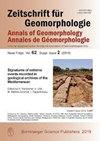Pleistocene fluviatile deposits in the Ourika drainage basin (Marrakech High Atlas, Morocco): indicators of climatic variations associated with base level change
IF 1.3
3区 地球科学
Q3 GEOGRAPHY, PHYSICAL
引用次数: 3
Abstract
Aggradational packages of alluvial sediment are preserved in the Ourika river basin. Field mapping and DEM analysis allowed us to identify a model sequence of river terraces. We focus on sites where the study of sedimentary sections allow us to decipher the sedimentary evolution of the Ourika watershed. Quaternary evolution of the drainage basin is characterized by major phases of sediment accumulation and erosion, forming alluvial fans and cut-fill terraces. More intense rainfall events during the Middle Pleistocene Ourika drainage basin resulted in increased erosion and transport of sediment from the hillslopes into the trunk river. First, the cut-fill terraces near the sub-basins outlets are formed by a large-scale aggradation, followed by a main vertical incision and lateral erosion. Then, the second sedimentation period was probably a result of increased precipitation that caused landsliding in steep sub-basins. Finally, a last stage of incision in the Ourika Valley is linked to a base level lowering due to climatic fluctuations. We suggest that cyclic climatic fluctuations superimposed on a continuous uplift of the High Atlas are responsible for the generation of stepped terraces along the Ourika River. Sub-basins steep affected by erosion processes dominated by landslides rocky shallow were accompanied by debris flows along convex profiles at their downstream end and associated with steep knickpoints. We interpreted erosion of the Pleistocene deposits as the result of an autocyclic negative feedback such as exhaustion of the hillslope sediment stocks and the resulting increase of the relative capacity of the trunk stream to bring and transfer sediment towards the Ourika Valley.Ourika流域(摩洛哥马拉喀什高地图集)更新世流质沉积物:与基准面变化有关的气候变化指标
乌里卡河流域保存了冲积沉积物的堆积包体。实地测绘和DEM分析使我们能够确定河流阶地的模型序列。我们的重点是研究沉积剖面,使我们能够破译乌里卡流域的沉积演化。流域第四纪演化以积沙和侵蚀为主要阶段,形成冲积扇和切填阶地。中更新世欧里卡流域的强降雨事件增加,导致泥沙从山坡向干流的侵蚀和搬运增加。首先,子盆地出口附近的切填阶地是由大规模淤积、纵向主切割和侧向侵蚀作用形成的。第二次沉积期可能是由于降水增加导致陡坡次盆地滑坡。最后,乌里卡山谷的最后一个切口阶段与气候波动导致的基准面降低有关。我们认为周期性的气候波动叠加在高阿特拉斯的持续隆起上,是沿乌里卡河产生阶梯式梯田的原因。受以滑坡为主的侵蚀作用影响的坡度较大的子盆地下游末端沿凸形剖面存在泥石流,并伴有坡度较大的断裂点。我们将更新世沉积物的侵蚀解释为自旋回负反馈的结果,如山坡沉积物储量的耗尽,以及由此导致的干流将沉积物带入和转移到Ourika山谷的相对能力的增加。
本文章由计算机程序翻译,如有差异,请以英文原文为准。
求助全文
约1分钟内获得全文
求助全文
来源期刊

Zeitschrift fur Geomorphologie
地学-地球科学综合
CiteScore
2.00
自引率
4.50%
发文量
14
审稿时长
6-12 weeks
期刊介绍:
Zeitschrift für Geomorphologie main volume is a peer-reviewed international journal presenting original contributions of high scientific standard from all fields of geomorphology, encompassing basic research and applied studies. Zeitschrift für Geomorphologie (ZfG) invites the submission of original papers from the entire field of geomorphological research, both applied and theoretical. Authors are encouraged to submit their papers to the editor-in-chief. Please peruse the instructions to authors (PDF) before submitting your paper.
 求助内容:
求助内容: 应助结果提醒方式:
应助结果提醒方式:


